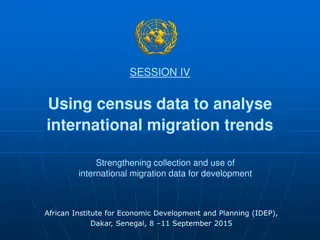Influencing Labor and Migration Choices of University Students in Mozambique
This project explores how subjective expectations impact the decisions of university students in Mozambique regarding employment, earnings, occupation, and migration. By studying the role of expectations on educational and migration choices, the project aims to address issues such as university dropouts, youth unemployment, and skilled migration in the country.
Download Presentation

Please find below an Image/Link to download the presentation.
The content on the website is provided AS IS for your information and personal use only. It may not be sold, licensed, or shared on other websites without obtaining consent from the author.If you encounter any issues during the download, it is possible that the publisher has removed the file from their server.
You are allowed to download the files provided on this website for personal or commercial use, subject to the condition that they are used lawfully. All files are the property of their respective owners.
The content on the website is provided AS IS for your information and personal use only. It may not be sold, licensed, or shared on other websites without obtaining consent from the author.
E N D
Presentation Transcript
Subjective Subjective Expectations Expectations, , Labor Choices Choices and Migration Evidence from University Students in Maputo Labor Market Market and Migration Mariapia Mendola (University of Milano Bicocca, IZA and LdA) Luigi Minale (Universidad Carlos III de Madrid and LdA) Ines Raimundo (Universidade Eduardo Mondlane) IGC, Maputo March, 24 , 2016
Objective This project aims at studying the role of subjective expectations about employment and earnings in influencing occupational and migration choices of university students in Mozambique. By collecting detailed survey data from students at UEM we aim at shedding light on the underlying causes of important socio-economic issues such as high university drop out, youth unemployment and skilled migration (brain drain) in Mozambique.
Background -1 People take forward-looking decisions depending on expectations on their own returns (Kimbal, 1990) Subjective expectations are heterogeneous (we are agnostic on how they are formed) and people react to them making up their own mind over intertemporal choices In contexts of incomplete markets and high risk, uncertainty on ex-ante economic returns (as opposed to ex-post ones) may play a significant role in shifting key lifetime decisions - such as education, occupation, migration (e.g. Manski, 2004; Jensen 2010; Attanasio 2009; Delavande et al. 2011). Human capital investment decisions have been shown to have a long-lasting impact on wage inequality, economic growth, and employment, leading to interest in the subject from policy makers as well as researchers
Background -2 Not only expectations are important for people s sorting in specific economic outcomes (e.g. occupation), but perceived expected returns can easily become self-fulfilling (Reuben, Wiswall and Zafar, 2015)- For example Youngsters with low-expectations will have a smaller incentive to perform well academically, or subsequently they will be willing to accept a low-paying job offer and less likely to negotiate for higher salary because it is in line with their beliefs Students with high expected probability of working in the agricultural sector may believe such occupation is low-skilled and low-paid, therefore they will drop out from school and end up having a low wage.
Policy relevance.. In developing contexts, getting hard evidence on individual expected returns on key human capital investments may have important implications in terms of both education and labour market policy. Using choice data, while assuming homogenous earnings expectations, is problematic since observed choices might be consistent with several combinations of expectations and preferences- especially in contests of high heterogeneity and uncertainty. Getting to know people s expectations and how they act upon them may provide, ceteris paribus, direct evidence on the relevance and severity of imperfections (e.g. in the information or insurance market) in determining actual investment behavior.
..and questions: Are Mozambican youngsters informed about the actual labor market opportunities? Do young people have correct expectations (information) about returns to schooling (and dropping-out)? To what extent expected income uncertainty affect youngsters education and occupational choices? To what extent over- or under-estimated expectations play a role in the skill-mismatch in the labor market? And on migration choices?
Mozambique Mozambique has been growing steadily over the last decade (7%), mainly due to an extractive resource boom. Yet, job creation has been slow and unemployment rates hardly declined over the same period, especially among youth. On the supply side, more than 300,000 people enter the labor mkt every year and this is poised to increase at about 500,000 by 2025 (WB 2015) Rates of return to higher education has been increasing from 6% in 2002 to 18% in 2008. A higher education degree increases wages by 148% compared to those with secondary education (WB 2015)
Employment rates by gender and educational attainment (INCAF 2012) Employment rates by gender and educational attainment (INCAF 2012)
Employment rates by occupation / income source (INCAF 2012) Employment rates by occupation / income source (INCAF 2012)
Mozambique Expanding the share of skilled workforce is a crucial condition for long term and sustainable growth. The country has already prioritized the development of higher education with a focus on science and technology (PARP, CPS-WB 2014, WB-HEST, Let s Work etc.). The number of higher education institutions have increased from 3 to 48 btw 1992 and 2014, also thanks to strong links with private sector. This is intended to address a problem of skills mismatch, to respond to a fast demand of highly specialized skills and to improve productivity both in the formal and informal sector (WB 2014).
Mozambique Yet, so far the demand for tertiary educated workers has been still growing more rapidly than supply in Mozambique. Completion rates at higher education institutions are still low: only about one out of three of those who enroll into university do actually graduate (UEM 2012). Moreover, among those who graduate many decide to emigrate abroad (45%). This translate in companies often importing skilled labour from abroad (e.g. from neighboring countries and even overseas).
Data collection We plan to collected information on a random sample of (about 800) students from different years and majors (Arts&Social Sciences, Science, Engineering, Medicine, Architecture, Law, Economics, Mathematics, Informatics) in UEM through a unique survey We collect information on students current or intended major (if junior) For each major, we elicit from the students their expectations about their likelihood of choosing future careers (including migration) and how much they expect to earn in them, where the period of reference may be 10 years after they graduate (to recover the present value of lifetime earnings).
More specifically, we ask students what are their expectations with respect to possible future outcomes in each occupation under different scenarios (i.e. university degree, drop-out) the focus will be both on expected average income and on income variance. To measure the variance of income, the survey will elicit the probability density function of students expected earnings. It does this using five bins of different income levels and asks the students to allocate 100 points across the bins to reflect what they believe is the probability they would receive that level of income, conditional on successfully pursuing that occupation. We also ask students what is the probability they will end up in certain occupations (and in the migration status). We shall use broad groups to characterize possible careers: e.g. Science/Technology, Health, Business, Government/Non-Profit, Education and Law (Arcidiacono et al. 2014) Alternatively, we may characterize occupations as wage work, entrepreneurship and inactivity (Osman 2014).
Importantly, for all students in the sample, those probabilities and expected earnings are elicited for all possible occupation-major combinations, i.e. both for the chosen (or intended) majors and the counterfactual majors. This will allow us to examine the possible complementarities btw majors and expectations, both in terms of earnings and preferences (i.e. how attractive working in a particular occupation is with different majors). For example, expected returns for business carriers are highest for economics major, which in turn leads people to report higher prob of pursuing a business occupation in the (sometimes) hypothetical case that they were an economics major We further collect a wide range of background characteristics (including financial aid/constraints) of students as well as measures of risk aversion.
Analysis -1 By using subjective expectations data on occupations for all counterfactual majors, we are able to isolate the separate influence of monetary returns from non-pecuniary factors quantify the importance of sorting across occupation on ex-ante monetary returns, keeping all the rest constant. Identification: using stated choice is advantageous because we rely on expectations elicited at the time of the choice in a hypothetical scenario that we seek to explain; this is equivalent to a situation in which respondents preferences are elicited before they make their educational or career decision. Such timing mitigates the endogeneity issue.
the differential effect of a treatment on a 'treatment group' versus a 'control group' in a natural experimen Analysis -2 Hence, this kind of data allows us to do 3 things: (i) identify the ex-ante impact (treatment effect) of particular occupations (relative to a reference one) on earnings, for any given college major (and for both graduating and dropping-out) (ii) identify the ex-ante impact of migration on earnings, for any given college major (iii) identify the ex-ante impact of particular majors on the probability of working in any given occupation and on migration
Intended Q&A- 1 Do youngsters have well-informed or correct expectations about future earnings? We shall compare elicited expectations (in particular wrt earnings) with actual data from IOF 2014-15 (most recent data containing some labor market information) From this set of information we see where UEM students believe they rank relative the population (if possible, by comparing earnings by major-occupation combinations or at least by educational attainment)
Intended Q&A- 2 To what extent expected economic returns (pecuniary and non-pecuniary) affect people behavior with respect to human capital investment decisions? We do so by looking at the difference between the ex-ante treatment effect of occupation k on the treated (i.e. by weighting the difference in the reported earnings by the probability pithe individual reports she will work in occupation k) and the ex-ante treatment effect on the untreated (i.e. by using the weighting (1- pi)) The latter gives a measure of the importance of selection on the expected returns to each occupation (a positive difference is consistent with positive sorting on expected earnings in different occupations- the magnitude of the difference is also important though)
Intended Q&A- 3 What is the role played by expected earnings in the choice of students occupation? What is the role played by expected earnings in the choice of students migration? We can look at this by estimating the probabilities of choosing particular occupations as a function of the (log) expected earnings controlling for individual-occupation preferences (dummies) and major- occupation fixed effects. This may be derived by as simple model of occupation choice, which provides a link between subjective expectations and preferences, making it possible to tell apart the role of expected earnings and non- pecuniary factors in this context.
Alternative follow-up interventions Students are re-interviewed after they graduate, allowing for the measurement of how their actions in the labor market line up with their reports in the first round of the survey Students are followed over time in order to collect their actual occupational choices and realizations (Part of the) students are provided with information about the distribution of incomes in the different occupations (either domestically or abroad). Students are asked again to provide their expectations of outcomes in the different occupations and the corresponding updates to their occupational/migration intentions. This allows for the measurement of how the expectations and intentions are impacted by an information intervention.























